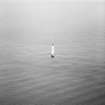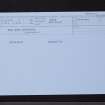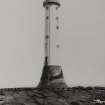Following the launch of trove.scot in February 2025 we are now planning the retiral of some of our webservices. Canmore will be switched off on 24th June 2025. Information about the closure can be found on the HES website: Retiral of HES web services | Historic Environment Scotland
Bell Rock Lighthouse
Lighthouse (19th Century)
Site Name Bell Rock Lighthouse
Classification Lighthouse (19th Century)
Alternative Name(s) Inchcape Rock
Canmore ID 36215
Site Number NO72NE 1
NGR NO 76165 26808
Datum OSGB36 - NGR
Permalink http://canmore.org.uk/site/36215
- Council Angus
- Parish Arbroath And St Vigeans
- Former Region Tayside
- Former District Angus
- Former County Angus
The Bell Rock lighthouse, which is situated in the North Sea some twelve miles to the south-east of Arbroath, is the oldest surviving rock-built lighthouse in Britain. First lit on 1 February 1811, it was designed by Robert Stevenson and is capped by an octagonal lantern. The construction of the lighthouse proved a great challenge, as the rock on which it is built is only exposed at low tide. The lighthouse has been unmanned since October 1988, and is now served by an automatic light and foghorn.
Information from RCAHMS (SC) 23 July 2007
NO72NE 1 76165 26808
For associated signal tower in Lady Loan, Arbroath (NO 6405 4044), see NO64SW 54.
For shipwrecks of Quixotic (1939), HMS Argyll (1915) and River Lossie (1917) on the Bell Rock, see NO72NE 8001, NO72NE 8002, NO72NE 8003 respectively.
For the loss of the York and the discovery of cannon and cannon balls, see NO72NE 8012 and NO72NE 8013 respectively.
NMRS REFERENCE
Historic Scotland - Listing updated 3.10.2000 from 45197 to 21230. (Undated) information in NMRS.
Engineer: Robert Stevenson 1806-11.
EXTERNAL REFERENCE
National Library of Scotland:
Scots Magazine, July 1908 - engraving.
Employment of seamen for building the lighthouse.
Letters from the Agents of the Commissioners of Lighthouses.
They ask that seamen employed by them should be protected from impressment.
1808 GD 51/2/1041/1-4
Bell Rock Folio (per Mr R.Q.C Stevenson): -
Notice to Mariners authorising the erection of a lighthouse on Bell Rock, to place a Floating Light there, and to collect duties thereupon. Printed with engraved map.
17. Bell Rock Floating Light 15 September 1807.
18. Bell Rock Light. (Large sheet covering two pages bound into the spine of the volume.)
Plan of Lighthouse Proposed to be erected upon the Bell Rock.
Figures 1-3 Plans.
Figure 4 Showing method of raising and lowering the cut building stone.
Figure 5 Section.
Figure 6 Elevation.
Pen and grey wash. Signed: M. Downie [Murdoch Downie). Verso: titled Bell Rock Light, Downie's Plan.
19. Elevation of the Lighthouse to be Erected on the Bell Rock. Engraved for the Scots Magazine & Edinburgh Literary Miscellany published by A. Constable & Company, 1 July 1801 accompanying an article. (Description of the Plan for the Bell Rock Lighthouse.)
20. Correspondence between Sir John Rennie (1794-1874) and Mr Alan Stevenson (1807-65) relative to the Bell Rock Lighthouse 1849. (The Civil Engineers and Architects' Journal for May 1849.)
21. Account of the Bell Rock Lighthouse. Second title page in Stevenson's Account of the Bell Rock Lighthouse, 1824. Between pages 64 and 67. Night scene of the Bell Rock Lighthouse drawn by Miss Stevenson, from a sketch by Skene of Rubislaw. Engraved by J. Horsburgh, printed by McQueen.
Includes a facsimile of the handwriting of Sir Walter Scott inscribed in the Album kept at the lighthouse, adding the line 'Pharos Conquitur'.
22. Bell Rock Lighthouse During a Storm from the North East.
Drawn by J.M.W. Turner R.A., engraved by J. Horsburgh, printed by McQueen.
Frontispiece (title page) to Stevenson's Account of the Bell Rock Lighthouse, 1824.
Probably based on sketches made by Andrew Masson, artist, who resided in the lighthouse from December 1816 for approximate ... weeks, which he made available to J.M.W. Turner.
23. Bell Rock Lighthouse in a storm.
Printed-ink process.
[24.]
25. Bell Rock Lighthouse on the north eastern coast of Great Britain. No 92. H. Davie sculpt.
26. Missing.
27. Elevation of the Light House erected on the Bell Rock. Engraved. R. Scott, Sculpt. Printed and sold by Patrick Wilson, Bookseller, Arbroath.
The sheet of paper has been folded.
Verso: 'Posted to' Robert Stevenson Esq. Northern Lights Office, Edinburgh. Dated Arbroath OC 15 1842. Stamped 'With Mr Wilson's respectful compliments Arbroath 15 Oct 1842.'
28. Bell Rock Lighthouse. (Large sheet of paper mounted across two pages). Watercolour perspective. Scale 1/5" - 1 foot. Signed London 21 July 1807 John Rennie (1761-1821).
(Undated) information in NMRS.
As originally built, the light was occulting alternate red and light, for recognition.
D B Hague and R Christie 1975.
This rock lighthouse is situated (in exceptional isolation) on a rock 'near the centre of the great sea-bight between Fife Ness and the Red Head of Angus'. The rock is barely uncovered at low water and had seen several unsuccessful attempts to establish a light upon it before the present structure was built by John Rennie and the young Robert Stevenson in 1806-11 using the principles established by Smeaton at Eddystone.
The tower is 100 ft high, the lowest 14 ft being solid, and is built of granite from Rubislaw, Aberdeen, and sandstone from Mylnefield, near Dundee. As originally constructed it had a reflecting light in lantern of octagonal form; a fog bell tolled by machinery was installed subsequently.
The lens-system was changed to Stevenson's latest hyper-radiant dioptric system in 1902 (the original lantern and parapet wall being replaced) and an incandescent paraffin-oil burner or mantle was installed (initially on an experimental basis) in 1904-5. The tower suffered machine-gun damage from a German aircraft in October 1940 but was undamaged in a bombing attack the following year.
The tower was modernised and the light electrified in 1963-4, and has been fitted with a RACON beacon.
R W Munro 1979.
Name: Bell Rock (1807-11)
Location: N56 26 W2 23 North Sea, 12 miles SE of Arbroath
Designed and built: Robert Stevenson
Light first exhibited: 1 Feb 1811
Description: circular granite tower, now painted white
Height of light above MHW: 92ft (28m)
Height of tower: 118ft (36m)
Light source and characteristics: W Fl (1) ev 5 secs. Acetylene: 1,900,000 cp: 18nm nominal range
Fog warning apparatus: Horn (2) ev 60 secs
Manning: unwatched (automatic since 26 October 1988), monitored from Northern Lighthouse Board HQ, Edinburgh
The oldest existing rock tower in Britain; Robert Stevenson's finest work. A severe fire in September 1987 delayed the automation programme
C Nicholson 1995.
This tower lighthouse is the earliest of the great lighthouse built by the Stevenson family. It both guards the approaches to Montrose and Arbroath, and also serves as the landfall light for mariners approaching the Tay estuary mouth from the E and NE.
This lighthouse is one of the four in Scottish waters over 10 miles from land, the others being Sule Skerry (HX62SW 1), Flannan (NA74NW 8.00) and Dubh Artach (NM10SW 1).
Information from RCAHMS (RJCM), 1 May 2006.
Construction (1807 - 1811)
Designed and built by Robert Stevenson. Ths construction of the lighthouse proved a great challenge, as the rock on which it is built is only exposed at low tide.
R W Munro 1979
The engineer John Rennie was appointed 'Chief Engineer' and was involved with the structural design and hydraulics. Stevenson (appointed assistant engineer to supervise the work under Rennie's superintendance) was involved in the direct management of the works on site and for devising a range of original apparatus to enable the carrying out of the woks.
R Paxton and J Shipway 2007b
Reproduced from 'Civil Engineering heritage: Scotland - Highlands and Islands' with kind permission of Thomas Telford Publishers.
Design (1807 - 1811)
Measured Survey (1900)
Modification (26 October 1988)
The lighthouse was automated, and subsequently unmanned, on the 26 October 1988.
C Nicholson 1995
Note (1 May 2006)
This tower lighthouse is the earliest of the great lighthouse built by the Stevenson family. It both guards the approaches to Montrose and Arbroath, and also serves as the landfall light for mariners approaching the Tay estuary mouth from the E and NE.
This lighthouse is one of the four in Scottish waters over 10 miles from land, the others being Sule Skerry (HX62SW 1), Flannan (NA74NW 8.00) and Dubh Artach (NM10SW 1).
Information from RCAHMS (RJCM), 1 May 2006.
Publication Account (2007)
The Bell Rock is a treacherous reef in the North Sea covered with about 14 ft of water at high tide and about 12 miles offshore from Arbroath. In the past it was notorious for shipwrecks and from 1800 Robert Stevenson, then Smith’s
assistant at the Northern Lighthouse Board, proposed the erection of a stone lighthouse. The eventual construction of the lighthouse built from 1807 to 1811 ranks as one of the world’s greatest civil engineering achievements in the
maritime field.
Initially there were doubts as to the practicability of the project and the Board enlisted the support of the eminent Rennie to obtain the necessary act of parliament for the lighthouse in 1806. Rennie was appointed ‘Chief Engineer’
with Stevenson as ‘assistant engineer to execute the work under his superintendence’. Rennie’s contribution related chiefly to the hydraulic and structural design of the tower, and Stevenson’s to the execution by direct labour,
involving novel temporary works such as the beacon, cranes and railway, and the provision of state-of-the-art lighting.
The tower is 115 ft high, 42 ft diameter at the base tapering to 15 ft diameter at the top and containing some 28 000 cu. ft of four different types of stone weighing some 2100 tons, the bottom 30 ft of which is of solid dovetailed masonry. The cost, which exceeded £60 000, included the erection of a work yard at Arbroath where each course of stone was prepared, cut to shape and assembled on a platform before being shipped out to the rock. At the rock the stones were handled by ingenious cranes and transported over its irregular surface on a cast-iron railway,
much of which still exists. These innovations, including the iron balance crane, forerunner of the modern tower crane, were invented by Francis Watt working under Stevenson’s direction.
In 1824 Stevenson’s classic account of the project was published, which although very detailed, does less than justice to Rennie’s fundamental contribution. In 1848 the sons of both men fuelled a great engineering controversy by publicly claiming that it was their father who had ‘designed and built’ the lighthouse, a matter now better understood with the ready availability of the papers of both families. Its successful accomplishment reflects great credit on both, particularly on Stevenson for overcoming the exceptional difficulties of its execution. The lighthouse, the oldest surviving rock lighthouse in the United Kingdom, has a nominal range of 28 miles and is now fully automated.
R Paxton and J Shipway 2007b
Reproduced from 'Civil Engineering heritage: Scotland - Highlands and Islands' with kind permission of Thomas Telford Publishers.




































